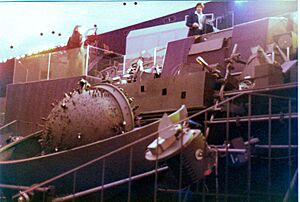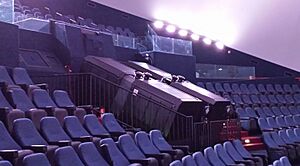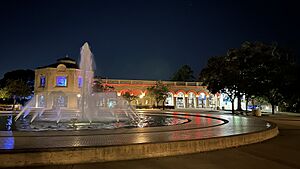Fleet Science Center facts for kids
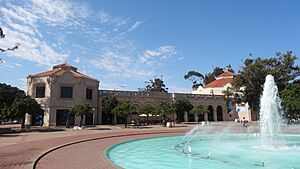 |
|
| Lua error in Module:Location_map at line 420: attempt to index field 'wikibase' (a nil value). | |
| Established | 1973 |
|---|---|
| Location | 1875 El Prado Drive, Balboa Park, San Diego, California 92101 |
| Public transit access | SDMTS |
The Fleet Science Center is a fun science museum and planetarium located in Balboa Park in San Diego, California. It opened in 1973. This center was special because it was the first science museum to mix hands-on science exhibits with a planetarium and an IMAX Dome theater. This new idea became a model for many other big science museums around the world. You can find it at the east end of the El Prado Drive walkway, right next to the Bea Evenson Fountain.
Contents
How the Fleet Science Center Started
The science center is named after Reuben H. Fleet. He was a pioneer in aviation, meaning he was one of the first people to do important things with airplanes. He even started the U.S. Air Mail service. Reuben Fleet's company, Consolidated Aircraft, was based in San Diego. They built famous planes used in World War II, like the B-24 Liberator and PBY Catalina. Reuben Fleet and his family gave the first money to start the Science Center.
The Planetarium's Special Design
In the 1960s, a group called the San Diego Hall of Science planned a new planetarium for Balboa Park. They also thought about adding a science hall next to it. A spot for the building was saved in 1963.
The planetarium was designed with many new ideas. It would show both large movies and regular planetarium shows. The dome, which was about 76 feet (23 meters) wide, was tilted 25 degrees. The audience would sit in rows facing outward into the tilted dome. This made it feel like they were floating in space and looking forward. The founders also wanted to get rid of the big, dumbbell-shaped star projector. This type of projector usually sits in the middle of the room and blocks some of the view. It would also get in the way of movies.
The San Diego Hall of Science asked Spitz Laboratories to create a new kind of star projector. This new projector would not block the view or interfere with movies. Spitz created a special "starball" that became the main part of the system. They called it a "Space Transit Simulator" (STS). This round star projector and other smaller planet projectors stayed low. They showed a very real-looking sky for astronomy presentations. All these parts, plus slide projectors and lights, were controlled by a PDP-15 computer.
Unlike older planetariums, which only showed the night sky from Earth, the STS could show the sky from far out in space. It could show how the sky would look from about 100 astronomical units from Earth. That's about three times the distance of Pluto's orbit! An operator could even use a joystick to "fly" the theater through space. This showed how planets seemed to move. However, most shows were pre-programmed.
The World's First IMAX Dome Theater
The Fleet Science Center also has the world's first IMAX Dome Theater. It shows huge films on a giant dome screen. Besides planetarium shows, the museum's founders wanted to show large movies on the dome. They asked IMAX to change their film system for a curved screen.
IMAX changed its 65mm film format for the dome. They called this new system OMNIMAX. Cameras used a fisheye lens to capture a wide view, but the image on the film looked distorted. When projected onto the dome with another fisheye lens, the distortion was fixed. The audience then saw a wide, realistic view. It felt like being right there in the scene. IMAX now calls this system "IMAX Dome."
The theater opened in 1973 as the Reuben H. Fleet Space Theater and Science Center. It showed two films: Voyage to the Outer Planets (a mix of planetarium show and OMNIMAX film) and Garden Isle (an OMNIMAX film).
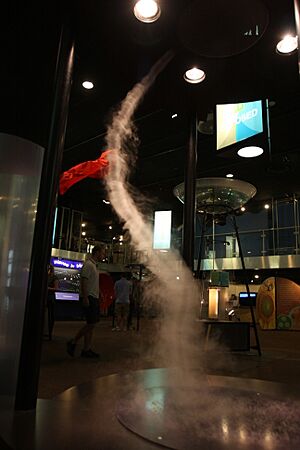
A New Kind of Science Center
The Fleet Science Center also set a new standard for science museums. Like the Exploratorium in San Francisco, which opened four years earlier, all exhibits at the Fleet had to be hands-on. Visitors could touch, move, or play with something. This idea of combining a planetarium, an IMAX Dome theater, and interactive science exhibits is now common in many big science museums.
Recent Changes and Updates
By the late 1990s, the science center felt a bit small and old compared to newer museums. In 1998, the center was made bigger and more modern. It added things like the Virtual Zone, which offered virtual rides with a science theme. The science exhibits became much larger than the planetarium/theater. So, the name was changed to the Reuben H. Fleet Science Center. In late 2016, it was simply rebranded as the Fleet Science Center.
The old STS planetarium system was used for many years. It was replaced by a newer system called Evans and Sutherland Digistar II in 2001. The building is also known for being very energy efficient.
The Heikoff Dome Theater Today
In 2012, the theater was renamed the Eugene Heikoff and Marilyn Jacobs Heikoff Dome Theater. This happened after a large gift from the Irwin Jacobs family. The planetarium system was improved again. It now uses two Global Immersion GSX systems. Each system has two Sony SRX 420 4K video projectors.
The renovation also improved the dome's screen. It became the world's first NanoSeam Dome screen in an IMAX Theater. This system is used for both live planetarium shows and digital movies. However, IMAX Dome movies are still shown using the original film projector and fisheye lens.
Around the same time, the center started making its own video shows. These shows cover different science topics and are designed for the dome screen. In 2021, the Fleet Science Center received a grant from Pfizer. This money helped them create programs about COVID-19 vaccines.
What You Can See at the Museum
A daily admission ticket to the Fleet Science Center includes all exhibits, galleries, and a show in the Heikoff Dome Theater. Here are some of the cool things you can find:
- More than 100 hands-on science exhibits in 8 different galleries.
- Special traveling exhibitions that change over time.
- Kid City, a fun area especially for children aged five and under.
- Studio X, a place where you can create and invent things.
- The North Star Science Store, where you can buy science-themed gifts.
- Craveology cafe, a place to grab a bite to eat.
- The Giant Dome Theater for amazing shows.
San Diego County residents can visit for free on the first Tuesday of each month. Other museums in Balboa Park have their own free days.
Exciting Exhibits to Explore
The Science Center has both temporary "Visiting Exhibitions" and "Permanent Exhibitions" in its galleries.
Some of the permanent exhibits you can always enjoy include:
- Design Zone
- Illusions
- It's Electric
- Kid City
- Nano
- Power Play San Diego
- Pulseworks VR Transporter
- San Diego's Water
- So Watt!
- Space Gallery
- Studio X
- Sun, Earth, Universe
Recent temporary exhibitions have included "The Art of the Brick," which featured amazing LEGO art. Another was "Taping Shape," an indoor landscape made from tape. "Science Fiction, Science Future" explored how science fiction ideas might become real.
Awesome Theater Shows
The Heikoff Dome Theater usually shows three IMAX films at a time. Current films include Dream Big: Engineering Our World, A Beautiful Planet, and Island of Lemurs: Madagascar. Sometimes, there are also special digital shows. These can be about science or even music and light shows.
A special planetarium show called "The Sky Tonight" happens on the first Wednesday of every month. The Fleet's astronomer-in-residence hosts it. The show focuses on what the sky looks like that month or on new astronomy topics. After the show, you can enjoy free outdoor telescope viewing. This is provided by the San Diego Astronomy Association.
See also
 In Spanish: Centro de Ciencias Reuben H. Fleet para niños
In Spanish: Centro de Ciencias Reuben H. Fleet para niños


